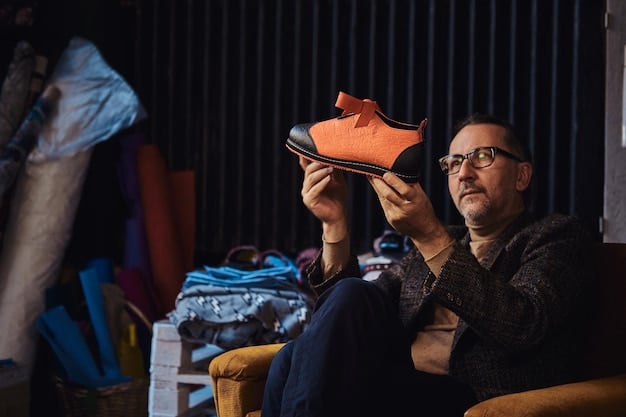Streetwear Resale Secrets: Flip Limited-Edition for 25% Profit

Unlocking significant profits in the streetwear resale market involves mastering authentication, identifying coveted limited-edition items, strategizing optimal buying and selling times, leveraging online platforms effectively, and meticulously tracking market trends to achieve a 25% profit margin within three months.
Venturing into the dynamic world of streetwear resale offers an exciting opportunity for significant returns, but navigating its complexities requires strategy and sharp insights. This guide to Streetwear Resale Secrets: How to Flip Limited-Edition Pieces for a 25% Profit in 3 Months will equip you with the knowledge to transform passion into profit.
Understanding the Streetwear Resale Market Landscape
The streetwear resale market has evolved from a niche hobby into a multi-billion dollar industry, driven by hype culture, limited releases, and the deep connection consumers feel to specific brands and designers. Understanding this landscape is paramount to achieving consistent profits. It’s not merely about buying and selling; it’s about anticipating trends, identifying demand, and acting decisively. The market thrives on exclusivity and the perceived value of scarcity, turning ordinary clothing into highly sought-after collector’s items.
The foundational elements of this market include brand prestige, influencer endorsements, and strategic product drops that generate immense hype. Brands like Supreme, Off-White, and certain Nike collaborations have mastered the art of scarcity, making their limited-edition releases instant sell-outs and prime candidates for resale. This ecosystem is further supported by a robust online infrastructure of resale platforms and social media communities, where information and transactions flow rapidly. To truly succeed, one must become a student of this culture, understanding its nuances and the psychology of its consumers.
Key Market Drivers
The primary drivers of the streetwear resale market are often rooted in cultural phenomena and brand strategies. Limited production runs create artificial scarcity, inflating demand and prices.
- 🔥 Hype Culture: Brands strategically create anticipation through cryptic announcements, celebrity endorsements, and short supply.
- 👟 Brand Collaborations: Partnerships between major brands (e.g., Nike x Off-White) consistently generate high demand and resale value.
- ⏳ Exclusivity and Scarcity: Limited releases mean not everyone who wants an item can get it directly, pushing them to the resale market.
- Influencer Impact: Endorsements from popular figures can instantly elevate a product’s desirability and resale potential.
Market Segmentation and Target Audiences
The streetwear resale market isn’t monolithic; it caters to diverse segments, each with unique preferences and purchasing power. Identifying your target audience is crucial for effective sourcing and selling.
Casual collectors might seek a specific piece to complete an outfit, while dedicated enthusiasts often pursue entire collections or rare archival items. Understanding these motivations allows for more targeted strategies. The market segments include sneakerheads, fashion collectors, and those simply looking for a status symbol. Each group shows varying levels of price sensitivity and brand loyalty.
Recognizing these segments helps in deciding which items to pursue, where to market them, and how to price them competitively to ensure a quick flip and a 25% profit.
Ultimately, navigating the streetwear resale market successfully requires more than just a keen eye for fashion. It demands a deep understanding of market dynamics, cultural trends, and consumer psychology. By developing these insights, flippers can position themselves to seize lucrative opportunities and achieve their financial goals. This intricate dance between supply, demand, and brand perception is what makes the market so exciting and profitable for informed participants.
Strategic Sourcing: Identifying High-Profit Limited-Edition Pieces
Sourcing the right pieces is arguably the most critical step in achieving a 25% profit within three months. This isn’t about guesswork; it’s about meticulous research, predictive analysis, and establishing reliable networks. Identifying items that will not only retain but actually appreciate in value requires a deep immersion in streetwear culture and an understanding of market timing. The goal is to acquire items below their potential resale value, anticipating future demand. This often means looking beyond the immediate hype to understand underlying factors that drive long-term desirability.
Understanding the unique characteristics of what makes an item “limited-edition” is vital. This could be due to a collaboration, a special release for an event, or an extremely low production count. These factors inherently create scarcity, which is the cornerstone of resale value. Without a clear understanding of what constitutes genuine scarcity versus manufactured scarcity, resellers risk investing in items that won’t deliver the desired profit margins. Successful sourcing is about intelligent acquisition, not just acquisition.
Researching Upcoming Drops and Releases
Staying ahead of the curve means actively tracking release calendars and news. Early information provides a significant advantage. It allows you to plan your acquisition strategy well in advance.
Platforms like Sole Retriever, SNKRS App, and various streetwear blogs are invaluable resources. Subscribing to newsletters and following key influencers on social media can also provide insider information. Pay close attention to brands that consistently produce highly sought-after items.
Key sources for upcoming drops include brand official channels, streetwear news sites, and dedicated release calendars.
This proactive approach allows for strategic planning, determining which items align best with your profit goals.
Authentication and Verification Best Practices
Counterfeit goods are a significant threat in the resale market, eroding trust and profits. Mastering authentication is non-negotiable. Learn to identify legitimate pieces from fakes by focusing on specific details.
Every brand has unique characteristics in stitching, labeling, material quality, and packaging. Familiarize yourself with these nuances. Utilize trusted authentication services like Legit Check by Ch or CheckCheck, especially for high-value items, before making a purchase or selling.
Developing a keen eye for authenticity protects your reputation and ensures customer satisfaction. This expertise is a cornerstone of building a reliable resale business, vital for success in the streetwear niche.
Networking and Building Supplier Relationships
Access to limited-edition items often goes beyond public releases. Building relationships within the streetwear community can open doors to rare finds and early access.
Connect with other collectors, local boutiques, and even brand associates. Attending streetwear conventions or local meet-ups can be valuable for networking. A strong network can provide opportunities to acquire pieces at or below retail, significantly boosting your profit margins.
These relationships are based on mutual trust and shared passion for streetwear. Cultivating them adds a crucial layer of competitive advantage to your sourcing strategy. It transforms random purchases into calculated acquisitions with higher profit potential.
The art of strategic sourcing is dynamic, requiring continuous learning and adaptation. By diligently researching, rigorously authenticating, and actively networking, resellers can consistently identify and acquire the limited-edition pieces that guarantee a 25% profit within the aggressive three-month timeline. This proactive and informed approach sets the foundation for sustained success in the competitive streetwear resale market.
Optimizing Your Selling Strategy for Maximum Profit
Once you’ve secured your limited-edition pieces, the next critical phase is to optimize your selling strategy to ensure you achieve that 25% profit margin within a tight three-month window. This involves more than just listing an item; it requires strategic platform selection, compelling presentation, smart pricing, and efficient shipping. Maximizing profit means minimizing costs and maximizing perceived value, all while facilitating a smooth and trustworthy transaction. Every decision, from taking listing photos to choosing a shipping provider, impacts your bottom line.
The urgency of the three-month timeframe necessitates a rapid turnover. This means avoiding items that might sit on the market for too long, even if they promise higher long-term returns. Focusing on high-demand, quick-flip items, and understanding market liquidity is key. Your selling strategy must be agile and responsive to market fluctuations, allowing you to adapt prices and marketing efforts as needed. Successful selling in this niche is as much about logistics and consumer psychology as it is about the product itself.
Choosing the Right Resale Platforms
The platform you choose can significantly impact visibility, fees, and speed of sale. Each platform caters to slightly different audiences and offers varying levels of seller protection and support.
Consider platforms like StockX for authenticated sneaker sales, GOAT for both new and used items, or Grailed for a broader range of streetwear apparel. eBay and Depop offer more flexibility but require solid authentication skills from the seller. Research their fee structures and typical selling speeds.
Popular platforms like StockX and GOAT offer built-in authentication, adding buyer confidence and facilitating faster sales.
Matching your item to the most appropriate platform is a key part of an effective selling strategy.
Effective Pricing Strategies and Market Monitoring
Pricing an item correctly is an art. Too high, and it won’t sell; too low, and you leave money on the table. Constant market monitoring is essential to find the sweet spot.
Track recently sold prices for identical or similar items on various platforms. Utilize tools provided by resale sites to analyze market trends and average selling prices. Be prepared to adjust your price based on demand fluctuations, new releases, or seasonal changes to ensure a rapid sale.
Dynamic pricing, informed by real-time data, is crucial for securing that 25% profit within your target timeframe. Understanding supply and demand dynamics is paramount for success.
Crafting Compelling Listings and Photography
Your listing is your storefront. High-quality photos and detailed descriptions are non-negotiable for attracting buyers and building trust.
Take clear, well-lit photos from multiple angles, highlighting key details and any imperfections. Provide an accurate and comprehensive description, including size, condition, authenticity details, and any notable features. Emphasize the limited-edition aspect to justify premium pricing.
High-resolution images and detailed product descriptions enhance buyer confidence and speed up sales.
A professional-looking listing minimizes questions, speeds up transactions, and maximizes the perceived value of your item. This attention to detail sets successful flippers apart from the rest.
Optimizing your selling strategy is a multi-faceted process that combines market intelligence, strategic platform use, and impeccable presentation. By meticulously planning every step from listing to shipping, resellers can confidently navigate the market, achieve their 25% profit margin, and ensure a steady flow of successful flips. This systematic approach transforms potential into tangible financial gain.
Mastering Authentication: Safeguarding Your Investment and Reputation
In the high-stakes world of streetwear resale, where demand often outstrips supply, the proliferation of counterfeit goods poses a constant threat. Mastering authentication is not just a best practice; it’s an indispensable safeguard for both your financial investment and priceless reputation. A single misstep with a counterfeit item can lead to lost profits, negative feedback, and a damaged standing within the community, making future transactions difficult. Therefore, developing an expert eye for genuine articles is paramount.
Authentication involves a combination of trained observation, access to reliable information, and sometimes, the utilization of professional services. It’s about understanding the minute details that differentiate an authentic product from a well-made replica. This expertise instills confidence in your buyers, justifies premium pricing, and ultimately, ensures the smooth and profitable operation of your resale business. Without this mastery, the lucrative promise of streetwear resale quickly turns into a minefield of potential losses.
Spotting Common Counterfeit Tells
Every brand has unique identifiers and quality benchmarks that are difficult for counterfeiters to perfectly replicate. Familiarizing yourself with these specifics is your first line of defense.
Pay close attention to stitching patterns, material quality, printing accuracy on tags and logos, and overall construction. For sneakers, examine the shape, proportion, sole patterns, and box details. Research specific release details and look for inconsistencies.
Common counterfeit tells include poor stitching, incorrect fonts on labels, and inconsistent material quality.
These details, often overlooked by the untrained eye, are crucial indicators of authenticity.
Utilizing Professional Authentication Services
For high-value items or when uncertainty lingers, leveraging professional authentication services is a wise investment. These services offer an added layer of scrutiny and peace of mind.
Services like Legit Check by Ch, CheckCheck, or Sotheby’s for extremely rare items employ experts who specialize in identifying fakes. While there’s a fee, the cost is minimal compared to the potential loss from selling or buying a counterfeit. These services also provide authentication certificates, which can boost buyer confidence.
They act as a crucial safety net, particularly for resellers who are still building their authentication expertise. This external validation significantly strengthens your selling position.
Building a Knowledge Base of Brand-Specific Details
Each streetwear brand, from Supreme to Off-White, has its own unique set of authentication markers. Dedicate time to studying these specifics for the brands you intend to flip.
Regularly consult online guides, forums, and comparison videos that break down authentication points for different models and releases. Keep up-to-date with new releases, as counterfeiters adapt quickly. Over time, you’ll develop an intuitive sense for what’s real and what’s fake.
Deep dives into brand-specific details, such as Supreme’s box logo stitching or Nike’s factory tags, are essential.
This continuous learning process solidifies your expertise, making authentication a routine rather than a challenge.
Ultimately, mastering authentication is an ongoing journey of learning and vigilance. By combining careful personal inspection, strategic use of professional services, and continuous knowledge building, you can safeguard your investments, protect your reputation, and confidently navigate the profitable yet treacherous waters of streetwear resale. This expertise is a cornerstone of long-term success and a 25% profit within three months.
Logistics and Operations: Streamlining for Quick Turnover
Efficient logistics and seamless operations are the unsung heroes of achieving a 25% profit within a three-month timeframe in streetwear resale. It’s not enough to simply find and acquire desirable items; the speed and efficiency with which you process, store, and ship them directly impact your profitability and reputation. Every delay, every damaged package, and every customer service oversight chips away at your profit margins and can deter future sales. Streamlining these processes is about maximizing efficiency and minimizing friction points.
A well-oiled operational machine allows you to handle higher volumes, reduce overheads, and deliver a consistently positive customer experience. This translates directly into quicker sales cycles and higher satisfaction rates, which are both crucial for reaching your financial goals. From the moment an item enters your possession until it reaches your buyer, every step must be optimized for speed, security, and professionalism. Without robust logistics, even the most coveted items can become a source of frustration rather than profit.
Efficient Storage and Inventory Management
Proper storage protects your valuable items and ensures they remain in pristine condition, ready for immediate sale. Disorganized inventory leads to delays and potential damage.
Invest in clean, dry, and secure storage solutions to prevent dust, moisture, and odors from affecting your inventory. Implement a simple but effective inventory tracking system, whether it’s a spreadsheet or a basic app, to know exactly what you have and where it is.
Organized storage and clear inventory tracking prevent damage and speed up order fulfillment.
This systematic approach ensures your items are always in top condition and easily accessible, enabling rapid processing once a sale is made.
Packaging and Shipping Best Practices
Secure and professional packaging is vital for customer satisfaction and protecting your items during transit. Poor packaging can lead to returns or disputes.
Use sturdy boxes, ample padding (bubble wrap, packing peanuts), and waterproof poly mailers for added protection. Choose reliable shipping carriers with tracking and insurance options, particularly for high-value items. Always provide buyers with tracking information promptly.
Secure packaging and reliable shipping with tracking are essential for customer satisfaction and dispute prevention.
Selecting the right shipping provider based on speed, cost, and insurance options is also crucial for managing your profit margins.
Customer Service and Handling Returns
Excellent customer service can differentiate you from competitors, fostering loyalty and positive reviews, which are invaluable for a reseller. Even with the best intentions, issues can arise, making your response critical.
Respond to inquiries promptly and professionally. Be transparent about item condition and shipping times. If a return is necessary, handle it courteously and efficiently. Clear communication throughout the process can turn a potentially negative experience into a positive one.
Responsive communication and fair return policies build trust and encourage repeat business.
A reputation for reliability and fairness contributes significantly to long-term success and customer retention.
By meticulously planning and executing your logistics and operational strategies, you create a robust framework for rapid and profitable resale. Streamlined processes ensure that every aspect of your business, from storage to customer interaction, supports your goal of achieving a 25% profit margin within three months. This operational excellence is the silent engine driving consistent success in the competitive streetwear market.
Financial Management: Tracking Profits and Reinvesting Smartly
Achieving a 25% profit within three months is not just about making sales; it’s about meticulous financial management. Without accurate tracking of expenses, revenues, and actual profit margins, even high-volume sales can disguise a business that’s merely breaking even or, worse, losing money. Effective financial stewardship allows you to understand the true health of your resale operation, identify profitable trends, and make informed decisions about reinvestment. This proactive approach ensures sustainable growth and helps you consistently hit your financial targets.
Beyond simply counting money, financial management in streetwear resale involves understanding the nuances of transaction fees, shipping costs, and potential authentication expenses. It’s about seeing the bigger picture of your cash flow and ensuring that decisions today contribute to a stronger financial position tomorrow. Reinvesting profits strategically is equally important, allowing you to scale your operations, acquire more valuable inventory, and capitalize on new market opportunities. This cycle of profit generation and smart reinvestment is key to long-term success.
Tracking Expenses and Revenue Accurately
Detailed financial records are non-negotiable for understanding your true profitability. Guesswork can lead to inaccurate profit calculations.
Use a simple spreadsheet or accounting software to log every expense (item cost, fees, shipping materials, authentication costs) and every revenue stream (sale price). Categorize these transactions for easier analysis. This provides a clear picture of your net profit per item and overall.
Accurate tracking of all expenses and revenues is vital for calculating true profit margins.
This clarity allows you to make data-driven decisions, optimizing for profitability and minimizing unexpected costs.
Calculating True Profit Margins Per Item
The listed sale price is rarely your net profit. Various fees and costs eat into the gross profit, so understanding the actual margin per item is crucial for strategic pricing.
Remember to subtract platform fees, payment processing fees, shipping costs (both inbound and outbound), and any authentication fees from your sale price. This calculation reveals the actual profit earned on each flip, allowing you to fine-tune your sourcing and pricing strategies for future items.
Factoring in all associated costs, including fees and shipping, provides an accurate measure of net profit.
This granular understanding allows you to identify which types of items or brands offer the best profit potential.
Strategic Reinvestment for Growth
Once profits are generated, the decision of how to reinvest them is critical for scaling your operation. Smart reinvestment accelerates growth and maximizes future earnings.
Consider reinvesting profits into acquiring more high-demand, limited-edition items. You might also invest in better storage solutions, professional photography equipment, or even advanced market analysis tools. The goal is to use your earnings to enhance your operational capabilities and expand your inventory of profitable items.
Reinvesting profits into more inventory, better tools, or educational resources fuels business growth.
This cyclical process of earning and strategically reinvesting is fundamental to building a sustainable and highly profitable streetwear resale business.
Financial management is the backbone of any successful resale venture. By diligently tracking finances, precisely calculating profit margins, and making informed reinvestment decisions, you can ensure that your passion for streetwear translates into a consistently profitable business. This disciplined approach secures not just a 25% profit within three months, but also sustained financial success in the long term.
Scaling and Sustaining Your Streetwear Resale Business
After mastering the initial stages of profitable flipping, the natural progression is to consider how to scale and sustain your streetwear resale business for ongoing success. Achieving a 25% profit within three months is a fantastic start, but maintaining and growing that momentum requires strategic planning and adaptation. Scaling isn’t merely about buying more; it’s about refining processes, expanding your market reach, and continuously evolving with the ever-changing streetwear landscape. The goal is to create a resilient business model that can weather trends and consistent demand.
Sustaining profitability over time means staying agile, identifying new opportunities, and building a brand reputation that garners trust and repeat business. It also involves understanding when to diversify your inventory or experiment with new selling channels. As the market matures, so too must your strategies, ensuring that your methods remain effective and your profit margins remain robust. This long-term vision transforms a successful flipper into a thriving entrepreneur within the streetwear ecosystem.
Expanding Your Sourcing Channels
Reliance on a single sourcing method can limit your potential. Diversifying where you find items opens up new opportunities and reduces risk.
Explore international markets for unique releases, consider consignment opportunities, or even participate in raffles and online lotteries more aggressively. Building relationships with retail employees or other resellers who have excess inventory can also provide consistent access to coveted items.
Diversifying sourcing channels beyond initial retail drops expands inventory and reduces reliance on single sources.
This multi-faceted approach ensures a steady pipeline of limited-edition pieces, which is crucial for sustained growth.
Building a Personal Brand and Community Trust
In a market teeming with resellers, building a strong personal brand and earning the trust of the community can be your greatest asset. It fosters loyalty and repeat business.
Consistently deliver authentic items, provide excellent customer service, and be transparent in all your dealings. Engage with the streetwear community on forums, social media, and local events. A positive reputation can lead to direct sales and referrals, bypassing platform fees.
A strong personal brand, built on trust and authenticity, drives customer loyalty and direct sales.
This intangible asset becomes a significant competitive advantage over time, ensuring a loyal customer base for future drops.
Adapting to Market Trends and Seasonal Shifts
The streetwear market is constantly evolving, with trends emerging and fading rapidly. Staying adaptable is critical for long-term survival and profitability.
Continuously monitor fashion blogs, social media trends, and industry news. Understand the seasonal demand for certain items (e.g., hoodies in winter, shorts in summer). Be prepared to adjust your inventory and pricing strategies to align with these shifts to maintain your 25% profit margin.
Flexibility in adapting to new trends and seasonal demands ensures continued relevance and profitability.
This proactive approach prevents inventory from becoming stagnant and ensures you’re always aligned with what buyers want.
Scaling and sustaining a streetwear resale business is an ongoing journey of learning, adapting, and innovating. By continuously refining your sourcing, building a reputable brand, and staying attuned to market dynamics, you can transform initial success into a lasting and even more profitable enterprise. This strategic foresight ensures that your business doesn’t just survive but thrives in the competitive and dynamic world of streetwear resale.
| Key Point | Brief Description |
|---|---|
| 🔍 Research Drops | Stay ahead by tracking upcoming limited-edition releases from key brands. |
| ✅ Authenticate Strictly | Master verifying authenticity to protect investment and reputation. |
| 💲 Price Strategically | Use market data to set competitive prices for quick, profitable flips. |
| 📈 Reinvest Smartly | Channel profits back into inventory and growth for sustained success. |
Frequently Asked Questions About Streetwear Resale
While achieving a 25% profit in three months is an aggressive but attainable goal, quick flips depend heavily on item desirability and market demand. High-hype sneakers and limited collaborations often sell within days or weeks, provided they are priced competitively and listed on appropriate platforms. Your efficiency in sourcing and listing also plays a crucial role.
The primary risks include falling for counterfeit items, misjudging market demand for a particular drop, and accumulating dead stock that doesn’t sell. Market trends can shift rapidly, causing prices to drop unexpectedly. High platform fees and shipping costs can also eat into profits if not carefully managed. Always prioritize authentication and market research.
Not necessarily. While more capital allows for more inventory and higher-value items, you can start small with a few accessible, high-demand items. Focus on proven winners like popular sneaker models or highly anticipated apparel drops that have a strong secondary market. Gradually reinvest your profits to scale your operations and acquire more expensive pieces over time.
To avoid selling fakes, always acquire items from reputable sources, such as official brand websites or trusted retailers. Develop a keen eye for physical authenticity markers like stitching, tags, and material quality. For critical items, utilize professional authentication services like StockX or Legit Check by Ch to verify their legitimacy before listing them for sale.
For high-value items, always opt for tracked and insured shipping services from reliable carriers. Double-box sneakers and use ample padding to prevent damage. Require a signature upon delivery to ensure safe receipt and protect against fraudulent claims. These precautions mitigate risks and provide peace of mind for both you and your buyer, safeguarding your profits.
Conclusion
Navigating the competitive yet lucrative world of streetwear resale demands a blend of passion, strategic planning, and meticulous execution. By mastering the art of strategic sourcing for limited-edition pieces, implementing an optimized selling strategy, rigorously authenticating items, streamlining logistics, and diligently managing finances, achieving a 25% profit margin within three months is not just an aspiration but a tangible goal. The journey requires continuous learning and adaptability, but the rewards—both financial and personal—are significant for those who commit to understanding its intricate dynamics and evolving with the market.







